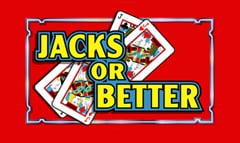The “best” basic strategy for 9/6 Jacks or Better
A lot has been written about Jacks or Better. Even more has been written about its most popular paytable, 9/6 Jacks or Better. What do I have to add?
I didn’t expect to have anything to add, except that I ran my homebrew basic strategy generator on 9/6 Jacks or Better just to test it, and I discovered that I can slightly improve the return of the basic strategies out there. My software tries to find the basic strategy with the absolutely highest return possible for a given paytable, and it seems that the most common basic strategies out there don’t have the absolutely highest return. They leave a tiny bit of extra return on the machine, namely 0.00002% (about one in five million).
Now, there are a lot of advanced strategies for Jacks or Better 9/6 out there too, with exceptions and penalty rules and all that. Some of those are even computer perfect. I am not talking about those kind of strategies. I’m only taking about basic strategies in this post.
I define a basic strategy to be a strategy that does not depend on the other cards in the hand. Also, a basic strategy must be just a list of various options, presented in some order. It shouldn’t say “if this, then hold that instead”. The Wizard of Odds Strategy Calculator (WOOSC) generates such strategies. So does Video Poker for Winners. Some of Dancer and Daily Basic strategies are also basic in this way, but when they go outside this restriction and include rules such as “A > AH when no other card suited with A”, they stop being basic according to my definition, because they start to rely on other cards in the hand and stop being just an ordered list of options.
I must admit, the basic strategies for 9/6 Jacks or Better that are out there are a little simpler than my strategy. But it is surprising to me that no one I could find had tried to squeeze out the last bit of return from a basic strategy for the game.
Let me tell you why my 9/6 Jacks basic strategy has a slightly higher return than the others. It’s mostly due to the fact that most strategies divide SF3 options into three or four classes based on the number of high cards and the number of “insides” (which are either holes or limitations on how many ways an option can become a straight flush). But that is not absolutely the best way to divide SF3s into groups for 9/6 Jacks or Better. For example, JT7 is better to hold than AKJT and AQJT, but in all the basic strategies I could find, it’s listed after them, together with some other SF3s. (Advanced strategies tend to have an exception implying that since JT7 doesn't have a straight penalty in such hands, it would be preferred to AHJT.)
Without further ado, here is my basic strategy in Dancer and Daily notation. It returns 99.542939%, compared to 99.542919% returned by the strategies in both the WOOSC strategy maker and the Dancer and Daily’s Basic strategy in their card for Jacks or Better.
RF5; SF5; 4-OF-A-KIND; FULL HOUSE 3-OF-A-KIND; TWO PAIR RF4 > FL5; ST5 > SF4
HIGH PAIR > RF3 > FL4
KQJT > low pair > ST4: 2345–9TJQ
SF3+1, SF3+0 [excludes 234 and A-low]
QJ
AKQJ
AH, KH SF3−1: JT7 > AQJT > QT8, J97 > AKHT, KQJ9
SF3−1: others [includes 234 and A-low]
KQJ
QJ > JT > KH > QT > AH > KT
A, K, Q, J > SF3−2
five new cards
I have also posted just the the strategy itself on a separate page here, so you can print it and use it.

Comments
Post a Comment